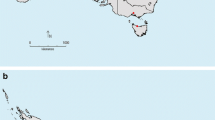Abstract
We studied genetic variation in Puccinia psidii, a newly introduced rust fungus in Hawaii, using microsatellite markers. All 36 Hawaiian P. psidii isolates analyzed had the same genotype at 11 microsatellite loci, while three genotypes were identified among four isolates from Florida and 11 genotypes among 18 isolates from Brazil. One of the isolates from Florida had 95% similarity to the Hawaiian isolates. We conclude that the genetically homogeneous P. psidii isolates in Hawaii might have derived from the same strain originally introduced into the Islands and are closely related to one of the strains found in Florida.

Similar content being viewed by others
References
Coutinho TA, Wingfield MJ, Alfenas AC, Crous PW (1998) Eucalyptus rust: a disease with potential for serious international implications. Plant Dis 82:819–825
Glen M, Alfenas AC, Zauza EAV, Wingfield MJ, Mohammed C (2007) Puccinia psidii: a threat to the Australian environment and economy—a review. Australas Plant Pathol 36:1–16
Kawanishi T, Uematsu S, Kakishima M, Kagiwada S, Hamamoto H, Horie H, Namba S (2009) First report of rust disease on ohia and the causal fungus, Puccinia psidii, in Japan. J Gen Plant Pathol 75:428–431
Killgore EM, Heu RA (2007) Ohia rust. Puccinia psidii Winter. New Pest Advisory No. 05-04. Hawaii Department of Agriculture, Hawaii (http://hawaii.gov/hdoa/pi/ppc/npa-1/npa05-04-ohiarust.pdf)
Marlatt RB, Kimbrough JW (1979) Puccinia psidii on Pimenta dioica in south Florida. Plant Dis Rep 63:510–512
Nelson RJ, Baraoidan MR, Vera Cruz CM, Yap IV, Leach JE, Mew TW, Leung H (1994) Relationship between phylogeny and pathotype for the bacterial blight pathogen of rice. Appl Environ Microbiol 60:3275–3283
Rayachhetry MB, Elliott ML, Van TK (1997) Natural epiphytotic of the rust Puccinia psidii on Melaleuca quinquenervia in Florida. Plant Dis 81:831
Rayachhetry MB, Van TK, Center TD, Elliott ML (2001) Host range of Puccinia psidii, a potential biological control agent of Melaleuca quinquenervia in Florida. Biol Control 22:38–45
Simpson JA, Thomas K, Grgurinovic CA (2006) Uredinales species pathogenic on species of Myrtaceae. Australas Plant Pathol 35:549–562
Tommerup IC, Alfenas AC, Old KM (2003) Guava rust in Brazil—a threat to Eucalyptus and other Myrtaceae. N Z J For Sci 33:420–428
Uchida J, Zhong S, Killgore E (2006) First report of a rust disease on Ohia caused by Puccinia psidii in Hawaii. Plant Dis 90:524
Zhong S, Yang B, Alfenas AC (2008) Development of microsatellite markers for the guava rust fungus Puccinia psidii. Mol Ecol Res 8:348–350
Acknowledgments
We thank Robert Anderson, Robert Hauff, Anne Marie LaRosa, Eloise Killgore, Janice Uchida, Min Rayachhetry, Les Szabo, and Acelino Alfenas for providing spores of Puccinia psidii or their DNA samples for this study.
Author information
Authors and Affiliations
Corresponding author
Rights and permissions
About this article
Cite this article
Zhong, S., Yang, B. & Puri, K.D. Characterization of Puccinia psidii isolates in Hawaii using microsatellite DNA markers. J Gen Plant Pathol 77, 178–181 (2011). https://doi.org/10.1007/s10327-011-0303-4
Received:
Accepted:
Published:
Issue Date:
DOI: https://doi.org/10.1007/s10327-011-0303-4



